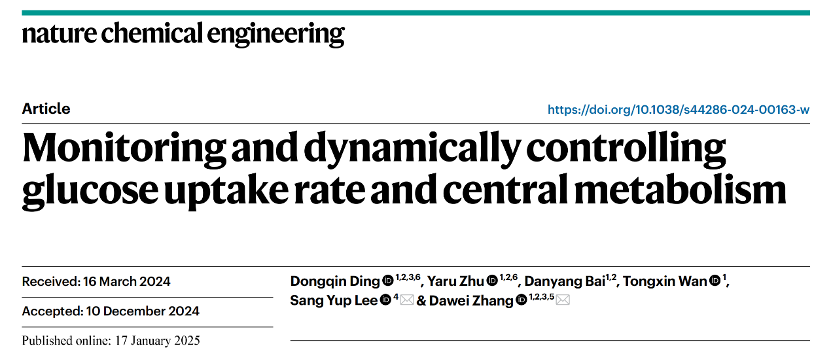Abstract
Systematic metabolism and synthetic bioengineering combine multidisciplinary technologies to create efficient microbial cell factories that promote green, low-carbon and sustainable production of medicines, chemicals and materials.
In the process of growth and metabolism of microbial efficient cell factory, its metabolic regulation is dynamic, and dynamic regulation is also a common mechanism and strategy in the process of microbial high yield and stress resistance.
As one of the important carbon sources, glucose uptake by cells is also the first step of their material and energy metabolism, which is particularly important for real-time monitoring and regulation. However, there is currently no technology or method to monitor and regulate the rate of glucose uptake by cells.
Recently, Zhang Dawei's team from the Tianjin Institute of Industrial Biotechnology of the Chinese Academy of Sciences published a paper in Nature Chemical Engineering: "Monitoring and dynamically controlling glucose uptake rate and central metabolism".
important progress has been made in monitoring and dynamically regulating glucose uptake rate and central metabolism.
content
In Escherichia coli, glucose is generally absorbed through the PTS system and transported into the cell through the EIBC channel, and Mlc protein is involved in the glucose uptake process. This study further analyzed the binding of Mlc and EIB and its mechanism of action after glucose uptake by cells.
based on this regulatory mechanism, the research team developed a real-time response glucose uptake rate biosensor (GURBs). By optimizing ptsG promoter, the relationship between glucose uptake rate and response signal GFP was successfully established, and a genetic circuit for positive and negative regulation of glucose uptake rate and central metabolic flow was established.
The performance and sensitivity of GURBs were verified by different experimental designs under different conditions.
Glucose monitoring biosensors have been applied in amino acid, vitamin and organic acid production strains.
By dynamically regulating the metabolic flow of the central metabolic pathway, the production of by-products was successfully reduced and the production of target metabolites was significantly increased.

Schematic diagram of development strategy of biosensing and regulatory elements for glucose uptake rate

Glucose monitoring and dynamic regulation system improves the biosynthesis of amino acids, vitamins and organic acids
After modification of traditional engineered microbial strains, metabolic flux imbalance often occurs, which affects cell growth and by-product accumulation.
The bi-functional genetic circuit that responds to glucose uptake rate developed in this study is an intelligent synthetic biology tool that dynamically optimizes metabolic pathways and efficiently synthesizes target products.
In the future, multiple biosensing elements can be integrated to fully regulate complex metabolic networks, thereby developing microbial cell factories that efficiently produce targeted chemicals.
Dongqin Ding, postdoctoral fellow, and Yaru Zhu, research assistant, Tianjin Institute of Industrial Biotechnology, are co-first authors.
Professor Sang Yup Lee, foreign academician of Chinese Academy of Engineering/Korea Advanced Institute of Science and Technology, and Researcher Zhang Dawei, School of Bioengineering, Tianjin Institute of Industrial Biology/Tianjin University of Science and Technology, are co-corresponding authors.
The project was funded by the National Key Research and Development Plan, the National Outstanding Youth Science Fund, Tianjin Synthetic Biology Promotion Action and other projects.






